

OVERVIEW
About the project
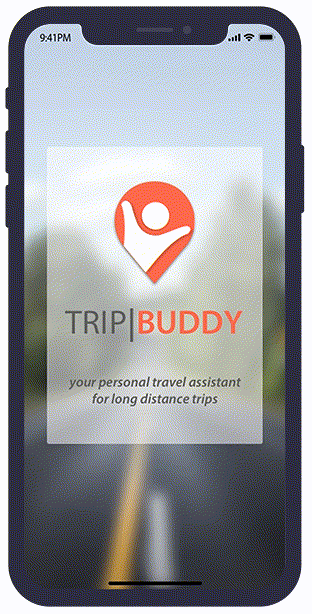
Fatigued driving is a dangerous and pervasive problem that poses significant risks to the safety and wellbeing of all drivers, cyclists, and pedestrians. My team and I explored this space to find if there is space for interventions that can aid fatigued drivers.
My Role:
As a designer, I conducted extensive research into fatigued driving in the form of a literature review, competitive analysis, surveys and interviews. After defining our main features I created a user journey map and a low & medium fidelity prototype of the in-car application and led usability tests.
Once the project was finished I redesigned the full application following feedback gathered from our usability study and created a new user flow.
Tools:
Sketch, Adobe Illustrator & Photoshop, Principle & InVision
Timeline:
10 weeks
THE CHALLENGE
What solutions can be developed to help drivers to stay engaged and battle fatigue on long freeway drives?
Drowsy driving is suspected to be a primary cause in more than 20% of road fatalities. Most fatigue-related accidents occur during normal sleeping hours, and the more severe the crash, the more likely it is that the driver or drivers were fatigued.
THE SOLUTION
Trip Buddy Cross-platform App
The application helps long distance drivers pre-plan their trip easily at home. It also provides a in-car system integration where a VUI assistant aids drivers in customizing their journey and presents them with engaging activities when on the road.

KEY FEATURES
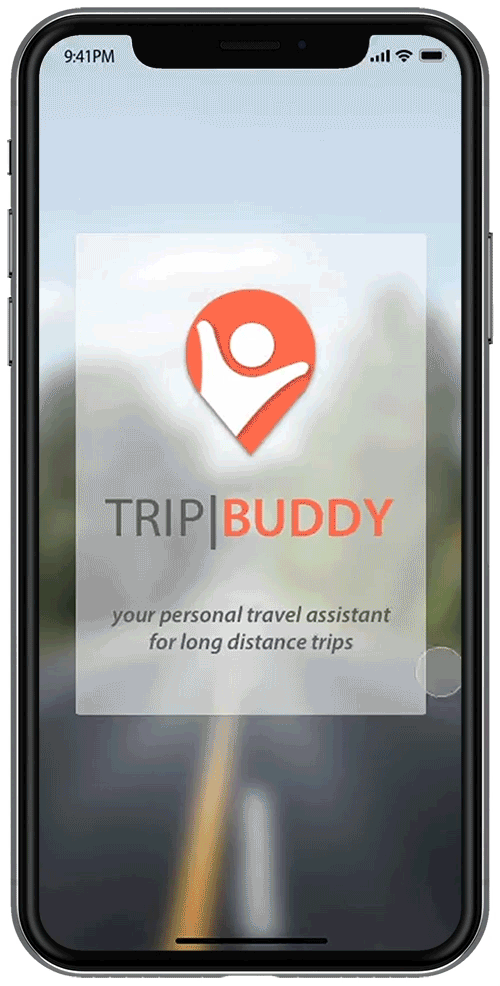
1. Set-up profile
Drivers can set up their personal trip preferences to receive the best recommendations for food and rest stops along their route. The preferences process is broken down into three simple steps.
-
Indicate diet & food preferences
-
Select safety, accessibility and lodging needs
-
Choose on the road activities
-
E.g. trivia, sign along, or call a friend
-
2. Create a trip
For further trip customization, drivers can also indicate if others are joining them on their trip, input the passenger's needs and choose how many stops they'd like to take.
This information is combined with the driver's preferences to determine the best possible route to the end destination. Drivers can then view the trip timeline and make necessary adjustments if needed.

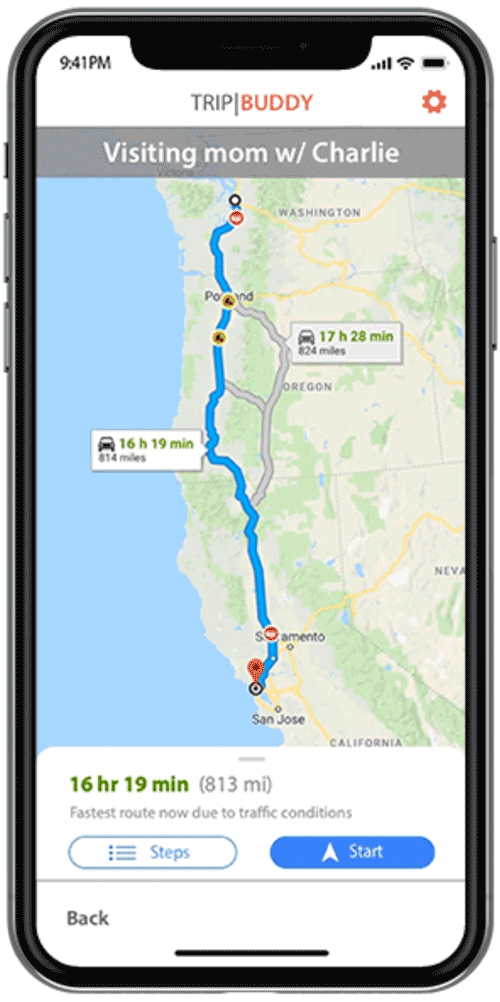
3. Privacy settings
Long distance drivers value minimal monitoring and thus the privacy settings were created. The notification shows during the on-boarding process and has basic settings turned on.
-
Location for Google Maps integration
-
Microphone for conversing with the VUI
Other integrations include Yelp, for more personalized break locations, and phone contacts so that drive can make calls through the app.
4. In-car application
Trip Buddy can be easily synced with Android Auto or Apple Car play to provide on the road assistance. The interface is integrated with Google Maps to keep drivers focused.
Key features:
-
In-car system interface
-
Trip timeline
-
Buttons: make a stop, re-center, make a call, notify VUI assistant, & start an activity
-
Dark mode and large button target area
-
-
VUI assistant
-
Allows users to make modifications to their trip and play engaging activities
-
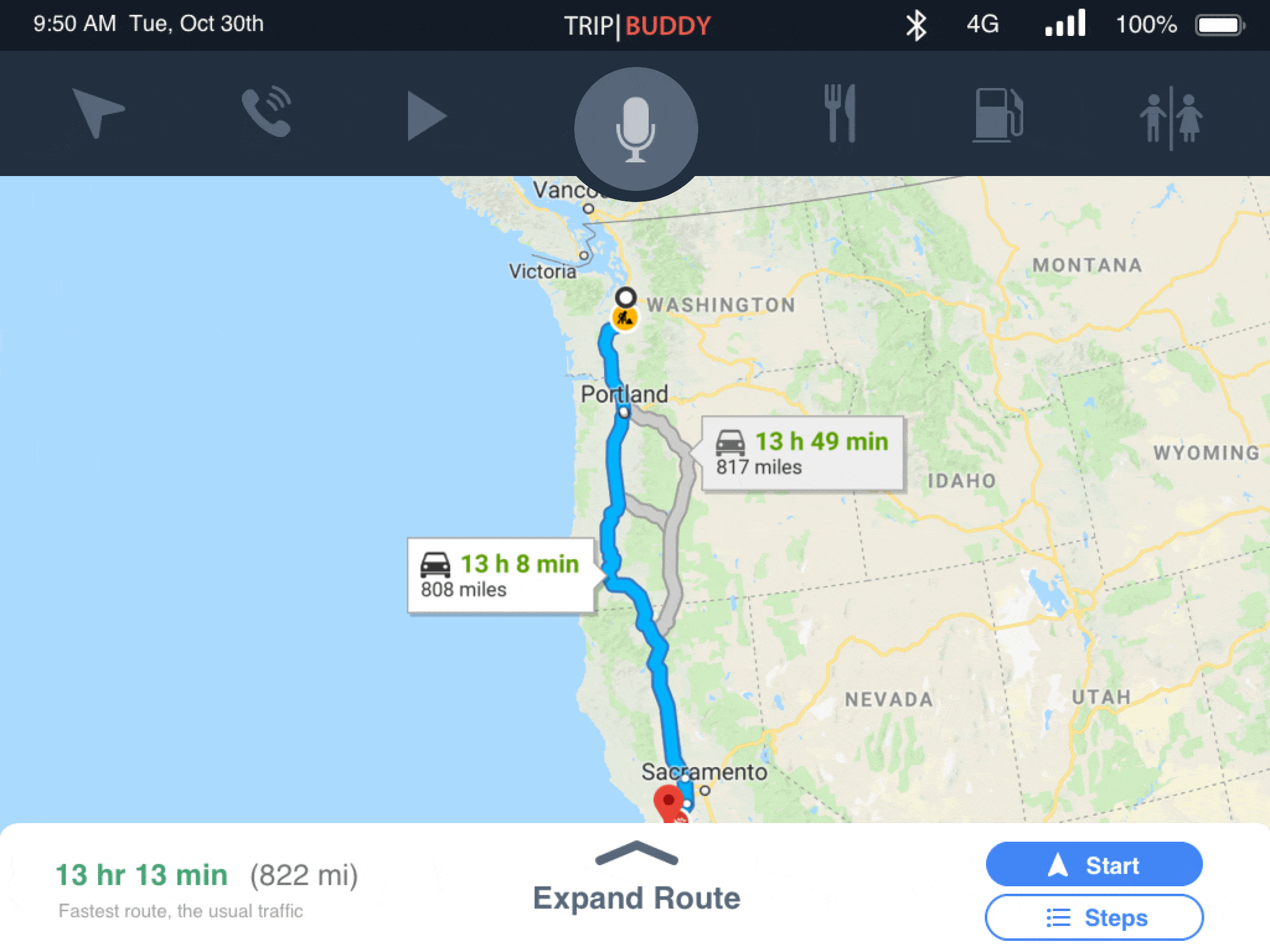
Prototype depicts a driver starting their trip and asking VUI to set an extra coffee break.
THE DESIGN PROCESS

RESEARCH
Identifying problem areas
The main goal of our exploratory research was to understand the needs and pain points of non-commercial drivers. Below are our findings from our initial research:
-
Rest and sleep are the only methods to battle fatigue when driving
-
There are no cost effective or fully tested systems that battle fatigue on the road
-
Individuals experience the most fatigue on long distance drives
-
Individuals who have driven +5 years experience more fatigue
These findings led our team to pivot and reframe our project scope to focus on experienced drivers (+5 years of driving) who embark on long-distance drives (+5 hours of driving). Below are our findings from the subsequent research:
-
Pulling over and taking a break was the least common activity to stay alert while driving
-
Drivers tended to be frustrated with their trip break locations
-
Drivers had mixed feelings about using a VUI
-
Drivers did not want to be monitored
Start
Literature Review
Stakeholder & Competitive Analysis
Shadowing
Initial Survey & Interviews (4)
(Pivot)
Second Survey & Interviews (3)
End
PROBLEM SPACE
Needs & constraints

-
Allow drivers to have the maximum amount of rest before their trip
-
Provide engaging activities on monotonous freeway stretches
-
Help drivers find the most comfortable rest stops
-
Ensure that the solution integrates within the driver's knowledge scope & will not distract them
-
Provide on the road assistance with minimal monitoring
USER PERSONA
Understanding the user
Based on our research findings, I created three personas that represent the challenges faced by our respondents and interviewees. We focused our further designs on our main persona, Amy, who is a student driving from Seattle to San Francisco with her dog to visit family.
IDEATION
Exploring ideas & opportunities
My team and I came up with three main solutions for our project. Our final sketches were: a VUI productivity assistant, a VUI road trip guide, and a VUI route assistant. We weighed the suitability of each idea against our design constraints and business factors such as , stakeholder buy-in and budget.
.jpg)
SELECTED FEATURES
Defining functionalities
We decided the main features of our proposed solution 'Trip Buddy' which integrates user preferences with an in-car assistant system when driving. The cross-platform application will allow drivers to:

Pre-plan trip before leaving

Customize on the road experience using the VUI while driving

Stay alert on the road by providing engaging activities

Easily navigate through the use of Google Maps

Integrate with Apple CarPlay & Android Auto
JOURNEY MAP
Identifying use case
I compiled all of the data gathered from our research and designed an experience map showing our main personas user journey through the process of using the Trip Buddy application.
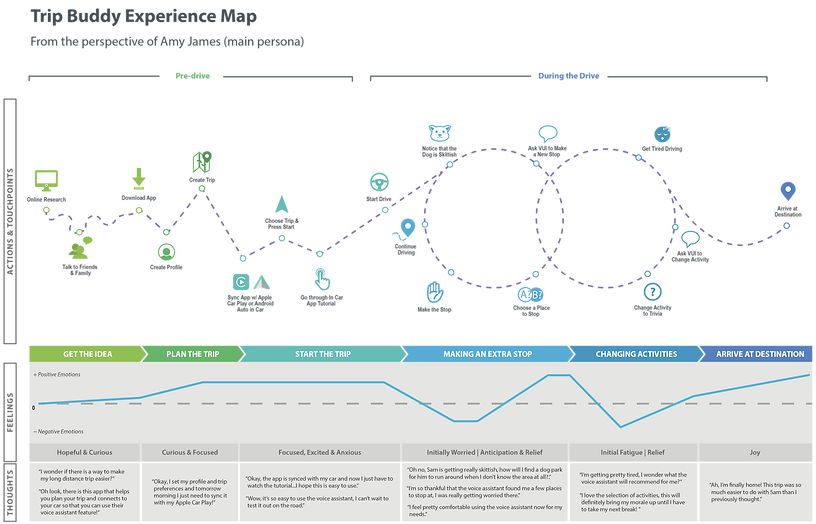
PROTOTYPE
Evaluation & revisions
My team and I performed two rounds of rapid prototyping, testing and iteration. We ran five low-fidelity usability and three mid-fidelity usability tests evaluating both the mobile and in-car application. After the end of the project I went on to incorporate the last of the participant feedback.

NEW USER FLOW
Once the project was over, I revised our user flow map to reflect the participant's feedback and designed a new use and onboarding flow.

CONCLUSION
Next steps & limitations
As a next step, I would like to test both the mobile and in-car applications once more. The mobile application could be tested through the creation of a summative usability study where the time on task, error rates and user satisfaction can be measured.
I followed the Android Auto OS app design guidelines when creating the car app GUI, but due to time constraints we tested our prototypes on an iPad tablet. Creating a realistic driving simulation through the use of VR might be a low-cost way to test our design on different car monitors, as well as test if playing trivia with the VUI is a safe activity to engage in while driving.
REFLECTION
Learnings
1. To get over a design block, list all of your assumptions
We encountered a design block when moving from the research to ideation stages of the HCD process after learning that sleep is the only safe method to combat drowsiness and that there are no tested technologies designed to battle fatigue on the road. Due to this information we could not see any opportunities for design interventions to help long distance drivers. By writing down all of our assumptions next to our design constraints we discovered that aiding drivers in their trip planning could be a way for drivers to gain more rest.
2. Don't try to solve for all problems
We tackled the fatigued driving problem from two sides. Through allowing drivers to get the most rest before their trip and providing drivers with engaging activities when driving. Deciding to include trivia as a feature to our in-car system was a tough choice because even though a similar system was found to be successful in Australia through the use of trivia highway signs, we were limited in time and could not create a fully robust in-car app testing system for our design.
Additional discussion
Points not covered by this case study but could be worth discussing in person:
-
Initial design concepts
-
In-car application design considerations
-
Prototyping challenges
-
Usability study protocol

